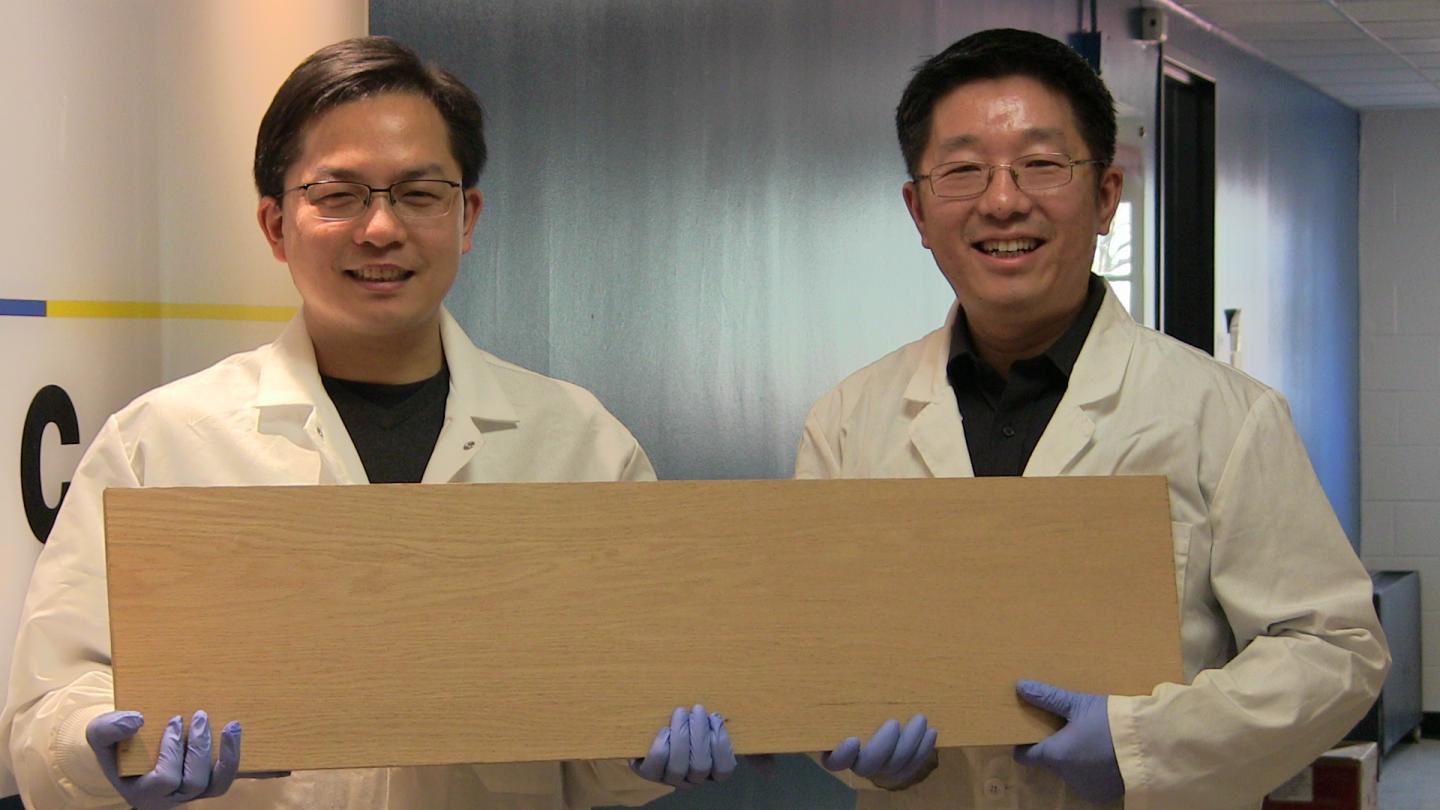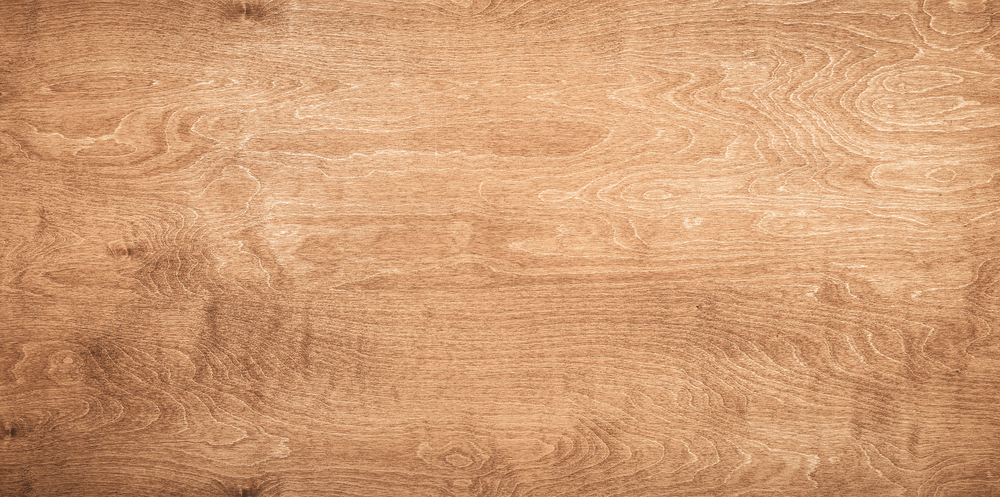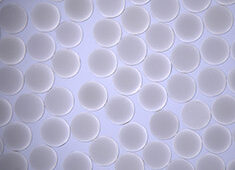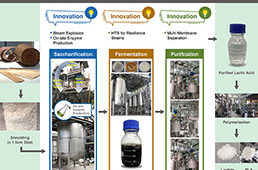
Liangbing Hu, left, and Teng Li, right, are engineers at the University of Maryland, College Park who have found a way to make wood more than 10 times stronger and tougher than before. Credit: University of Maryland
Researchers from the University of Maryland have developed a new method to make regular wood more than ten times stronger and tougher. The resulting material—which the researchers refer to as ‘super wood’—is as strong as steel, but six times lighter. It also requires 10 times more energy to fracture than natural wood and can be bent and molded at the beginning of the process.
The wood is treated in a two-step process, which involves the partial removal of lignin and hemicellulose from the natural wood via a boiling process in an aqueous mixture of sodium hydroxide and sodium sulfite. This is followed by hot-pressing, which leads to the total collapse of cell walls and the complete densification of the natural wood with highly aligned cellulose nanofibers, according to study researchers.
The discovery could be used as an alternative to steel. The new technology also enables manufacturers to use cheaper, softer woods like pine or balsa, rather than slow-growing, harder woods used in many industries.
Liangbing Hu, an associate professor at the University of Maryland and leader of the team, explained the super wood, which was part of a study that was published in Nature, in an exclusive interview with R&D Magazine.
R&D Magazine: How did your team develop the super wood?
Hu: Our group works with this kind of biomaterial a lot. I’ve always had an interest in using biomaterial for emerging technologies like batteries, water treatment, and environmental technologies. Since I joined the University of Maryland, we’ve been working on the so-called transparent paper. The idea is that you can take regular paper and develop a few processes that can almost instantaneously turn regular paper into a transparent substrate. The transparent paper is to really replace plastics for displays and packaging.
About two years ago, we developed a so-called transparent wood that is as transparent as glass to replace glass for energy efficient buildings. We further developed a process that would make wood about 10 times stronger than the starting material. It is almost as strong as steel but six times lighter. We call it a super wood. At the end of the day, we are trying to use the nanomaterial inside the wood, inside trees or inside the plants. If you look at a tree, you have all these tiny, tiny fibers along the growth direction of a tree. When you go down to nanosize you have a lot of very interesting properties, usually that are much stronger and at the same time flexible. They can be transparent.
By using this process, we can densify the wood. Traditional wood has all these big holes, you can even see them. The idea is to close the pore by pressing them. As you press the wood, you get rid of the big pores. The big pores are the mechanical defects if you are talking about the strength. That is why the wood breaks. We are not the first ones to talk about nanotechnology of wood. In the field, people have tried many, many ways to separate the fibers from trees. If you try to separate them, it is going to take a lot of time and energy. We took a top down approach. We are basically pressing them, you close the pores and we take the lignin out, which glues all the material together. What you learn here is you find out the lignin is very bad in achieving a high performance when people try to densify it. As we take this yellowish material (lignin) out, we find that we can press the wood even denser. As you get rid all of the open channels inside the wood, the material becomes extremely dense and it is pretty much like a metal. At the end of the day, you take something out, you press it and we find out this is the major trick for these amazing properties. You have to keep some of the lignin in because if you remove all of it, it is basically like a piece of paper, it is not stable.
R&D Magazine: What would you say the biggest challenge in creating the super wood is?
Hu: The challenge I think eventually will be to manufacture it. We are an academic environment, we are not too familiar with mass production. There are different rules we need to consider.
R&D Magazine: What industries do you see using this technology?
Hu: We have a company that is trying to commercialize this technology. This is patented technology. When you think about replacing steel, there are pretty much endless applications like furniture, cars, and airplanes. The beauty of this technology is it actually can transform wood, especially low-cost wood, into high-end product. Of course, there are a lot tricks in these processes. How can you avoid breaking it? How do you really scale up the manufacturing? So we’ve been continuing to optimize the processes. We’ve gotten interest from a range of companies. The furniture is industry is very interested. The construction industry, where the buildings should be light and at the same time strong.
R&D Magazine: When a product is made with the super wood, it is recyclable at the end of its lifetime?
Hu: At the end of the day, it is still a piece of wood. We don’t add anything into it, so it is recyclable.
R&D Magazine: Is the super wood cost effective to use?
Hu: The cost really depends on the processes. The goal is to compete with steel and many people are trying to replace steel. Steel is very good but it is very heavy and that costs a lot. If you save 10 percent of the weight of your car, you will basically save 10 percent on fuel consumption. If we are competing with carbon fiber, those materials are extremely expensive. There are so many potential applications. I think the first target applications should be on some of those high-end applications.
R&D Magazine: What are the next steps for your research team?
Hu: There are a few things we need to work out. We are basically optimizing the process and further improving the performance. There are many applications for which people have approached me. People want to make a guitar, people want to make all kinds of things.





